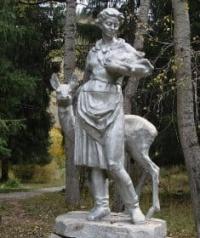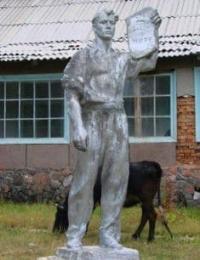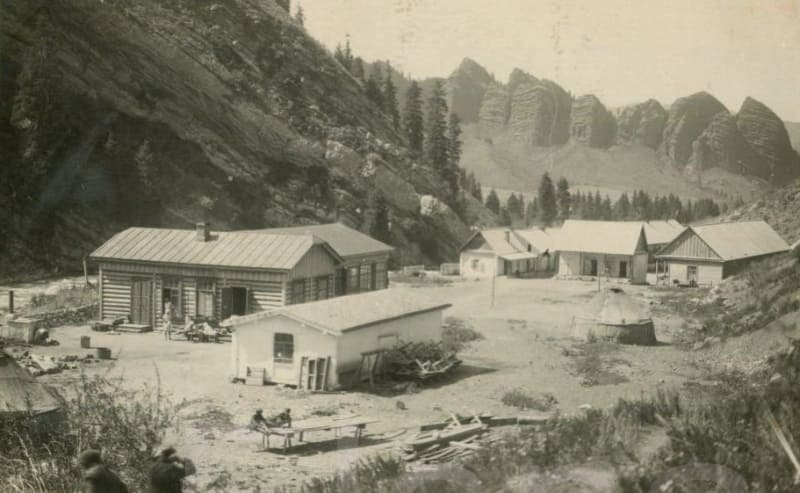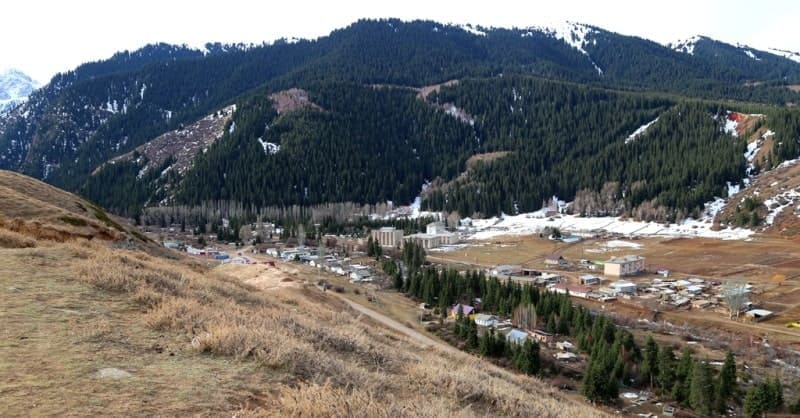Вы здесь
Resort of Dzhety-Oguz.


Trip to resort Dzhety-Oguz from Karakol.
"The radioactivity of the Jetty-Oguz spring is estimated at 248 units on the Mah scale per 1 liter. This is approximately fifty times more than at ordinary medical radioactive resorts. Like another famous Kyrgyz resort, Issyg-Ata, Jetty-Oguz has an exceptionally beneficial effect on rheumatics and those suffering from women's, skin and nervous diseases."
V. Vitkovich. "Kirgizia". 1938.
Luxury travellers in Kyrgyzstan.
Jety-Oguz resort is located at an altitude of 2032 meters above sea level, in Jety-Oguz gorge, 30 meters from left bank of river of same name, on northern slope of Terskey Ala-Too mountain range in Jety-Oguz district of Issyk-Kul region.
The Jety-Oguz resort is located 15 kilometers from the Balykchy-Karakol highway and is confined to the Koktebe tract, which is located in the western part of the resort, on the left side of the Jety-Oguz River. The healing waters of the Jety-Oguz resort are distinguished by high temperature and low radioactivity.
These are radon chloride-sodium-calcium, chloride-sulphate-sodium-calcium thermal waters. Hot radon springs of Jety-Oguz are distinguished by a high level of mineralization and are the most famous and popular springs in the country.
Depending on the composition, radioactivity, mineralization and temperature, hot springs are divided into:
a) highly mineralized,
b) mineralized and
c) weakly mineralized waters.
Hot springs also contain small amounts of bromine, iodine, boron, copper, lead, zinc, molybdenum, silver, strontium, germanium, as well as a number of organic substances such as bitumen, humin, phenols and volatile fatty acids. The Jety-Oguz resort offers visitors thermal mineral baths with temperatures from +37°C to +42°C as treatment procedures for diseases of the musculoskeletal and nervous systems, gynecological diseases.
Along with the mountain climate, the main natural healing factors of the Jety-Oguz resort are mineral waters and therapeutic muds (therapeutic sulphide muds of the Dzhergalan deposit, located 43 kilometers east of Jety-Oguz).
Jety-Oguz resort uses radon (up to 127 nCi/l) thermal waters of two types:
- sodium-calcium chloride and
- sodium-calcium chloride-sulphate.
The healing properties of the Jety-Oguz mineral springs have been known to the local population since ancient times.
For baths at Jety-Oguz resort, mineral waters of 1st type are mainly used:
- from well No. 1 "K" (daily flow rate of 208.2 cubic meters, temperature 41° C, mineralization 12.1 g / l)
- and from well No. 6 (daily flow rate of 229.8 m3, temperature 38.4° C, mineralization 10.1 g / l).
For drinking treatment, waters of the 2nd type are used (temperature 22.9° C, mineralization 3.6 g / l). In addition to climatotherapy, balneotherapy and pelloidotherapy, physiotherapy, massage, therapeutic exercises, terrain cure, etc. are used at the Jety-Oguz resort.
Indications for treatment at the sanatorium. Staying at the Jety-Oguz resort is recommended for those with musculoskeletal, nervous and gynecological diseases. The climate in the vicinity of the resort is continental. Winter is moderately mild, sunny, with little snow; the average January temperature is -9° C.
Summer is moderately warm; the average July temperature is 15° C. Precipitation is about 500 mm per year, mainly in April-October. Average annual relative humidity is about 65%. The number of hours of sunshine is 1828 per year. The springs are also famous for their mountain climate and picturesque landscape.
The nature around the resort is truly very beautiful and unique. The entire large western part of the gorge is occupied by the resort and its subsidiary farm. On the opposite side, a dense spruce forest descends to the resort along the northern slope of Mount Koktebe. The resort area is surrounded from the north by rocks of brick-red sandstones and gravitates.
History of Jety-Oguz resort.
The first organized exploitation of the Jeti-Oguz springs began in 1910 - 1913. Over small pools lined with stones, in the hot springs there were yurts replacing the bath cabin, where the local population, the sick, sought healing from their illnesses in the waters of the springs.
Only later were wooden baths and a room for 50 people built. The development of the modern resort began in 1931, in 1940 2 buildings of the sanatorium for 248 people, a bath department and a polyclinic were built. And only after the resort came under the jurisdiction of the People's Commissariat of Health of Kyrgyzstan, its systematic large-scale expansion and improvement began.
Resort science knows only a few springs that surpass the waters of Jeti-Oguz in radioactivity. Therefore, the balneological wealth of Jety-Oguz can be called unique to a certain extent. Their fame has long spread far beyond the borders of Central Asia - patients from Siberia, the Urals and the Central zone of the Russian Federation come here for treatment.
Radon decay products are adsorbed on the skin and form the so-called active plaque, during the decay of which the patient is exposed to radioactive irradiation for about 3 hours. Residential and medical buildings, a canteen, and shops have been built at the Jety-Oguz resort.
Geographic coordinates of Jety-Oguz resort: N42°19'50 E78°14'15



Authority:
Kyrgyzstan. “Mysl” publishing house. G. The Moscov. 1970.
https://teskei-geopark.com/ru/about/geology/dolina-skazka
Photos by:
https://foto.kg/galereya/400-kurort-dzhety-oguz.html
Alexander Petrov.







